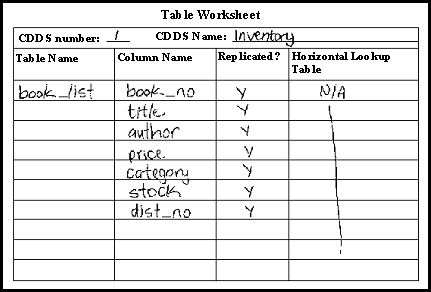A replication scheme is the set of replication definitions for a database. These definitions identify the following:
Your replication definitions are codified when you configure your Ingres Replicator installation.
You need an accurate representation of your replication scheme to accurately configure Ingres Replicator.
The planning worksheets help you to represent your replication scheme. When you are ready to start configuring Ingres Replicator, these worksheets will already contain most of the information you need to select appropriate options in configuration screens.
We recommend that you fill out the following worksheets:
The following table is a checklist of the tasks described in this section:
Task |
Check |
|---|---|
Fill in the Database Worksheet. Assign values for: |
|
Database numbers |
|
Fill in the CDDS Worksheet. Assign values for: |
|
CDDS number |
|
CDDS name |
|
Collision mode |
|
Error mode |
|
CDDS target type |
|
Replicator Server numbers |
|
Propagation paths |
|
Fill in the Table Worksheet (if necessary) |
|
This chapter uses a sample replication scheme, which is also used in the chapters "Configuring Replication Using Visual DBA" and "Configuring Replication Using Replicator Manager." For examples of other replication schemes and their worksheets, see Replication Scheme Examples.
The Database Worksheet defines the distributed environment for all CDDSs in your replication scheme. The following table describes the guidelines for filling in the Database Worksheet.
Value |
Guidelines |
|
|---|---|---|
Database Number |
This number is an enterprise-wide unique integer in the range of 1-32,767. Assign database numbers carefully; Priority Resolution and Last Write Wins collision modes can use the database number as the basis for deciding priority when resolving collisions. We recommend assigning database numbers in increments of ten, so that new databases can be added in between the original ones. |
|
Database Vnode/Name |
Database names must follow DBMS guidelines; Ingres Replicator does not impose further restrictions. The vnode is the Ingres Net virtual node name for the database. For more information on vnodes, see the Connectivity Guide. |
|
Database Owner |
The owner (DBA) of the database. |
|
DBMS Type |
The DBMS Type can be any one of the following: |
|
|
CA-Datacom/DB |
Microsoft SQL Server |
|
For more DBMS types, check the Readme file. |
|
Remarks |
User-specified, up to 80 characters. |
|
The following is an example of a Database Worksheet.

The following figure illustrates a completed Database Worksheet.
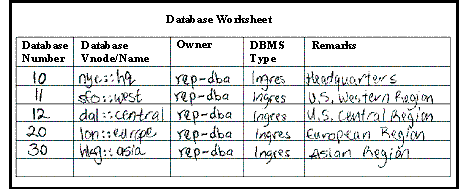
Carefully examine the way data is used among the different databases in your system to determine your CDDSs. Remember that CDDSs are indivisible and mutually exclusive; you cannot split the information in a CDDS so that it goes to different targets, and you cannot contain the same data in more than one CDDS. If you later decide to divide a CDDS, you must reconfigure Ingres Replicator.
For the definition of a CDDS and examples, see Consistent Distributed Data Set (CDDS).
The CDDS Worksheet is divided into the following sections:
The CDDS Worksheet and a sample completed CDDS Worksheet are at the end of this section.
The CDDS summary information defines the scope of the CDDS and how it handles collisions and errors. The following table describes how to fill in the CDDS summary section of the CDDS Worksheet.
Value |
Guidelines |
|---|---|
CDDS number |
This number is an integer in the range of 0-32,767. |
CDDS name |
This name is for your information only. It can consist of up to 32 characters. The default is Default CDDS. |
Major tables |
Fill in the names of the tables to be replicated. Use the Table Worksheet for more detail. |
Collision mode |
The possible values are:
|
Error mode |
The possible values are:
|
Use the CDDS Diagram to create a visual representation of your replication scheme. This overview of your replication scheme gives you an instant understanding of your plan and can expose errors or omissions in your plan.
The CDDS Diagram consists of the following elements:
Label each database with its name, number, and target type.
Draw a line for every path, and an arrow pointing at the target. Read-only targets have only incoming arrows, while full peer targets have incoming and outgoing arrows. Label each arrow with the number of the Replicator Server that is propagating to that target.
The database information describes the behavior of the database within the CDDS. The following table describes how to fill in the database information section of the CDDS Worksheet.
Value |
Guidelines |
|---|---|
Database Number/Name |
The database number, vnode, and name from the Database Worksheet. |
Target Type |
Possible values are:
|
Server Number |
The number of the Replicator Servers assigned to propagate transactions to the database. For more information, see Replicator Server Assignment. |
Based on the CDDS diagram, fill in propagation paths. For an explanation and examples of data propagation paths, see Data Propagation Paths in the CDDS.
Define worksheet entries so that an update that occurs on any of the full peer databases within the CDDS is propagated to all of the other databases that participate in the CDDS. For example, if you have two databases in the CDDS that act as full peers, each of them must be an originator in one propagation path and a target in another propagation path. The following table describes how to fill in the propagation path section of the CDDS Worksheet:
Value |
Guidelines |
|---|---|
Originator DB |
Fill in the number of the database where the transaction originated |
Local DB |
Fill in the number of the database that propagates the transaction to the target |
Target DB |
Fill in the number of the database that receives the transaction |
Comment |
This is for worksheet purposes only |
The following forms provide examples of CDDS Worksheets.
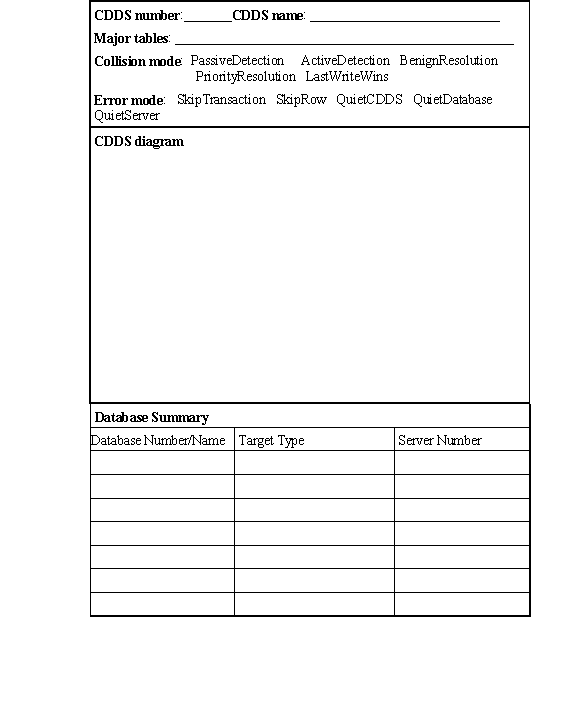
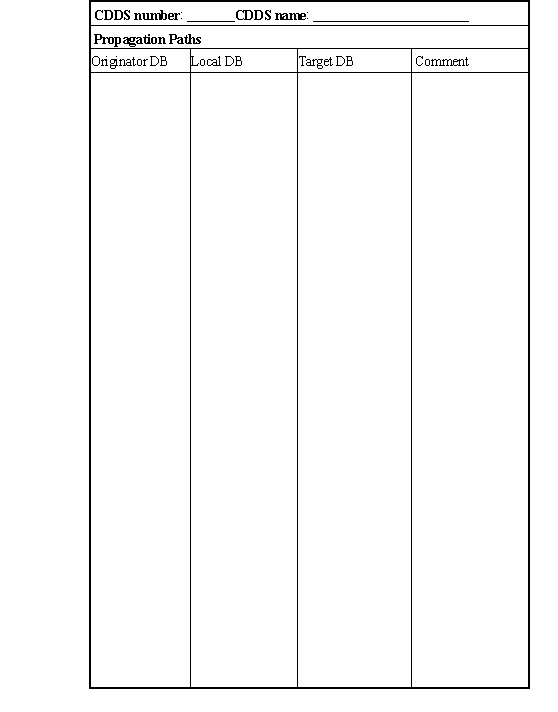
The following figure illustrates a completed CDDS Worksheet.
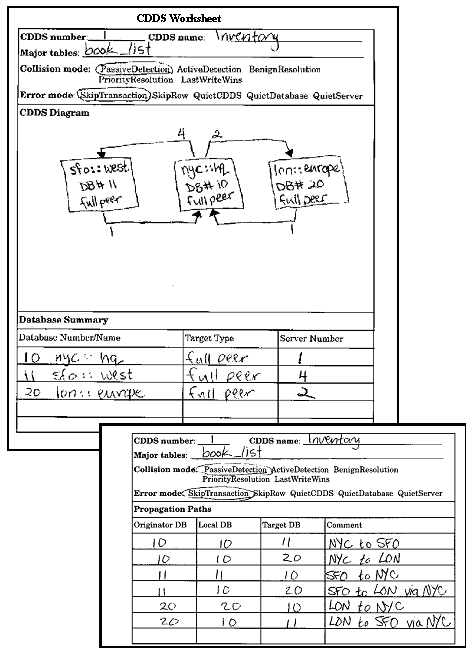
The Table Worksheet allows you to document your replicated table and column information in detail.
You must complete this worksheet if you are including vertical or horizontal partitioning in your CDDS. Vertical partitioning refers to replicating a subset of a table's columns. Horizontal partitioning refers to replicating a subset of a table's rows based on values in a particular column.
For information on how to use partitioning in your replication scheme, see Consistent Distributed Data Set (CDDS). For information on horizontal partitioning, see How You Set Up Horizontal Partitioning.
The following figure shows an example of a Table Worksheet.
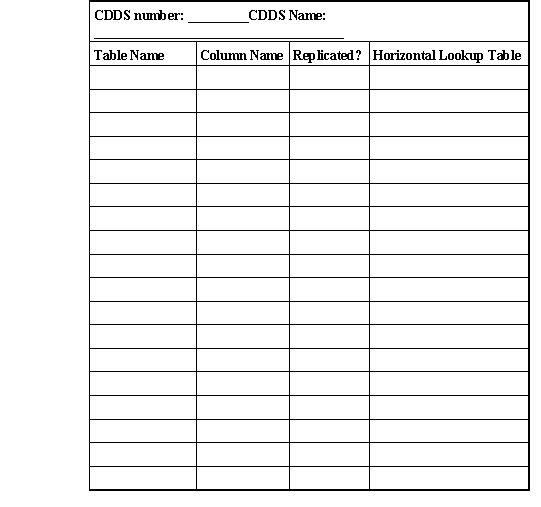
The following figure illustrates a completed Table Worksheet.
